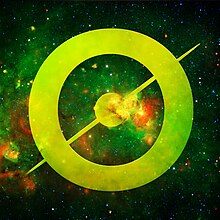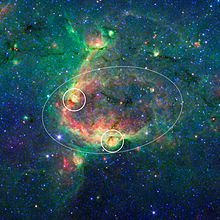The Milky Way Project

The Milky Way Project is a

Details
The Milky Way Project works with data taken from the Multiband Imaging Photometer for Spitzer Galactic Plane Survey (MIPSGAL) and Galactic Legacy Infrared Mid-Plane Survey Extraordinaire (GLIMPSE). Only a small part uses WISE data. The project looks for bubbles, which can mean the formation of stars. The project also looks for knots, star clusters, and other objects such as young stars, supernova remnants, and newly discovered galaxies.[2][3]
History
The Milky Way Project started as the ninth Zooniverse project in December 2010.[4][5] The phase 1 worked with the colors: 4.5 μm for blue, 8.0 μm for green and 24 μm for red. This resulted in the Data Release 1 (DR1) of the Milky Way Project in 2012 with 5,106 bubbles, which can also be found in SIMBAD.[6]
The annulus tool that was used to mark the bubbles in the Milky Way Project phase 1 was at random round and needed improvement. This problem was solved after the introduction of the ellipse tool. This new tool was used in the phase 2 of the project, short after DR1. This changed the classification and the tool does fit the actual shape of the bubbles. The phase 2 also used different colors: 3.6 μm for blue, 4.5 μm for green and 8.0 μm for red, the same three colors as GLIMPSE 360 in Aladin Lite.[7] Phase 3 is also called Phoenix since it started after a year offline[8] and it is now active. Phase 3 uses the same colors as phase 1 and the same ellipse tool as phase 2, combining the strength of phase 1+2.
The Milky Way Project did also search for star clusters and galaxies. Phase 2 additionally did search for Extended Green Objects (EGO), 4.5 μm emissions that seem to be connected to
The MWP classification aggregation pipeline is continuously tested and modified to avoid issues that were encountered in DR1.
The second Data Release was published in 2019, which contains 2,600 infrared (IR) bubbles and 599 candidate IR bow shock candidates. With a subset of highly reliable subset of 1394 IR bubbles and 453 bow shocks. The lower number of bubbles is being explained with a better quality of the catalog. The new catalog includes bow shocks near the star-forming regions NGC 3603 and RCW 49. The size of the bubbles in the catalog is proven to be as good as expert classifications and to be better than in previous works. The mysterious "coffee ring" is presented as well, but although this perfect ring in absorption was observed with the Green Bank Telescope, the nature of this object remains a mystery.[11]
See also
Zooniverse projects:
References
- ^ "Zooniverse". www.zooniverse.org. Retrieved 2017-02-23.
- ^ "Milky Way Project". Spacehack. Retrieved 28 September 2014.
- ^ "The Milky Way Project: Can you help?". Night Sky Network. Jet Propulsion Laboratory - California Institute of Technology. Retrieved 28 September 2014.
- ^ Zooniverse, The (2010-06-26). "Coming Soon…". The Milky Way Project Blog. Retrieved 2017-02-23.
- ^ ttfnrob (2010-12-07). "Site Goes Live". The Milky Way Project Blog. Retrieved 2017-02-23.
- S2CID 119108099.
- ^ tharinduj96 (2016-10-12). "A Brief History of the Milky Way Project: Why We (Still) Need Your Help". The Milky Way Project Blog. Retrieved 2017-02-23.
{{cite web}}: CS1 maint: numeric names: authors list (link) - ^ Povich, Matthew S. (2016-09-15). "The Milky Way Project: Phoenix". The Milky Way Project Blog. Retrieved 2017-10-13.
- S2CID 118387115.
- S2CID 119196894.
- .
